
By Bob Goemans

Some aquarists consider ‘crustaceans’ to simply be ‘shrimp-like’ creatures and often keep various species of shrimp in their aquaria, and/or feed their fish different forms of foods made from shrimp flesh. In fact, prior to writing this article I asked several shoppers in different local aquarium shops what a ‘crustacean’ was, and the answers were always the same, with some pointing to various shrimp in the store aquariums. I sure did get some odd looks when I asked that question, and even was asked if I had ever eaten shrimp! Of course I answered, but noted that I limit my intake as I monitor my cholesterol. And kidding aside, when I pointed to other forms of invertebrates in these aquariums, such as crabs, and asked if they were crustaceans, I got weird looks with some shoppers simply walking away from me shaking their heads.
Nevertheless, shrimp and other ‘Joint-legged Animals’ fall into the Phylum Arthropoda where they, shrimp, are accompanied by other ‘joint-legged’ creatures such as crabs, lobsters, sea spiders, isopods, crayfish, etc., and all are considered ‘crustaceans.’ There’s no doubt we aquarists are very familiar with some of the more common shrimp species, such as various ornamental shrimp, e.g., those cleaner shrimp in the Lysmata genus, such as L. amboinensis and L. grabhami. Theres also the gorgeous L. debelius, the Blood Red Shrimp, and L. wurdemanni, which serve as a control factor in extinguishing unwanted rock anemones. And then there are those that are simply interesting to watch, besides being beautiful such as Hymenocera elegans, the Harlequin Clown Shrimp; or the Banded Coral/Boxer Shrimp Stenopus Hispidus, which is technically more a lobster than a shrimp.
There are of course, quite a few more that are not quite as common as those mentioned above yet show up in the trade occasionally. But what about those real oddball shrimps and other joint-legged creatures that even divers rarely see, and when they do, are fortunate enough to photograph? And if we aquarists thought those commonly maintained in our aquaria were beautiful and fascinating, those rarely seen in the wild would easily outdistance them! This is why I thought an article devoted to these little-seen creatures would interest readers, as just seeing these magnificent looking animals gives one an appreciation for what remains in the wild that we know little about. And maybe with that realization, we will take part in some fashion to help preserve these wonderful natural areas in the wild!
Lets first look into the Superfamily Galatheoidea (Squat Lobsters), which contain animals not technically really lobsters, although they may look somewhat similar. These creatures usually have a flattened body and are more closely related to porcelain crabs, hermit crabs and somewhat, yet distantly, to true crabs.
A good example would be the Hairy Squat Lobster, Lauriea siagiani, sometimes called the “Sponge Crab, ” which is quite small, with it only reaching about 0.5 inch (1.5 cm). 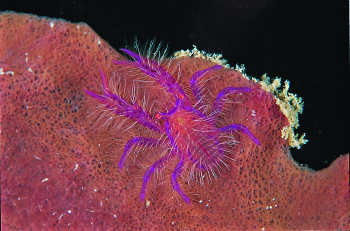 This odd looking creature hails from the Central Tropical Indo-Pacific: from Malaysia and Indonesia to the Philippines, and its neon-pink body and legs are covered with long white and pink bristles. It is usually found alone or in pairs on the outside surface, or sometimes inside, large barrel sponges belonging to the genus Xestospongis. This is a very cryptic species, generally feeding upon bits of organic matter caught on the surface of sponges as they filter water through their body tissue. This species has never been collected for the aquarium trade, and in fact, is rarely seen even by divers. Nevertheless, even if an attempt was made to collect this species, they have an exclusive host species, as is the case with many of the species discussed in this article, that would make it near to impossible to be properly maintained in closed systems (AKA, aquariums).
This odd looking creature hails from the Central Tropical Indo-Pacific: from Malaysia and Indonesia to the Philippines, and its neon-pink body and legs are covered with long white and pink bristles. It is usually found alone or in pairs on the outside surface, or sometimes inside, large barrel sponges belonging to the genus Xestospongis. This is a very cryptic species, generally feeding upon bits of organic matter caught on the surface of sponges as they filter water through their body tissue. This species has never been collected for the aquarium trade, and in fact, is rarely seen even by divers. Nevertheless, even if an attempt was made to collect this species, they have an exclusive host species, as is the case with many of the species discussed in this article, that would make it near to impossible to be properly maintained in closed systems (AKA, aquariums).
Another odd-looking member of this Superfamily is Allogalathea elegans, the Crinoid Squat Lobster or Feather Star Squat Lobster. 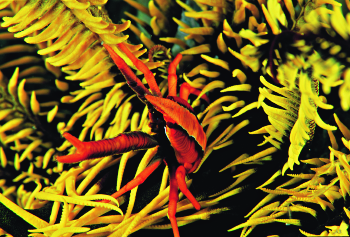 This is another tiny, less than 1-inch (2.0 cm) creature, yet is more widespread, with it being found on coral reefs throughout mostly the Tropical Indo-West Pacific from Australia north to Indonesia, the Philippines and Solomon Islands. It is only found in association with crinoids, i.e., feather stars, as they are its only host, and when found, usually exist in pairs with the female being slightly larger than the male. It has the typical flattened oval-shaped body with pointed and very long chelipeds, resembling those of true lobsters. Its coloration usually closely matches that of its host, allowing it to camouflage itself among the arms of the feather star. And since its hosts, only feather stars, are almost impossible to maintain in captivity, one can appreciate what the husbandry circumstances would be like with a host dependant species such as this!
This is another tiny, less than 1-inch (2.0 cm) creature, yet is more widespread, with it being found on coral reefs throughout mostly the Tropical Indo-West Pacific from Australia north to Indonesia, the Philippines and Solomon Islands. It is only found in association with crinoids, i.e., feather stars, as they are its only host, and when found, usually exist in pairs with the female being slightly larger than the male. It has the typical flattened oval-shaped body with pointed and very long chelipeds, resembling those of true lobsters. Its coloration usually closely matches that of its host, allowing it to camouflage itself among the arms of the feather star. And since its hosts, only feather stars, are almost impossible to maintain in captivity, one can appreciate what the husbandry circumstances would be like with a host dependant species such as this!
Moving to those in what are called ‘True Crabs’ in the Superfamily Portunoidea, Family Portunidae, the Zebra Crab Zebrida adamsii, is quite striking in appearance, which is probably an understatement! 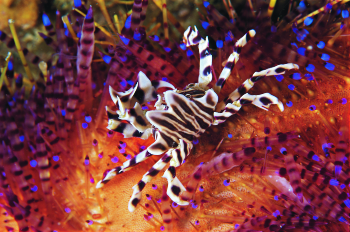 This tiny, uncommon crab, about 1 inch (2.5 cm) hails from the Tropical Indo-West Pacific from Malaysia to southern Japan, and in the wild is found in association with fire urchins, such as Asthenosoma varium and A. ijimai. Its white body has brown/purple bands, and its rear legs have hooks to keep a grip on its fire urchin hosts, where it takes refuge among its venomous spines. An attractive crab would be an understatement, and even though its host urchins are occasionally see in the trade, this little carpetbagger has not been found among them that I know of.
This tiny, uncommon crab, about 1 inch (2.5 cm) hails from the Tropical Indo-West Pacific from Malaysia to southern Japan, and in the wild is found in association with fire urchins, such as Asthenosoma varium and A. ijimai. Its white body has brown/purple bands, and its rear legs have hooks to keep a grip on its fire urchin hosts, where it takes refuge among its venomous spines. An attractive crab would be an understatement, and even though its host urchins are occasionally see in the trade, this little carpetbagger has not been found among them that I know of.
Another striking, little seen crab is Achaeus japonicus, the Orang-Utan Crab. Also quite small, about 0.5 inch (1.2 cm), it comes from Tropical Indo-Pacific: from Malaysia and Indonesia to southern Japan and the Solomon Islands. 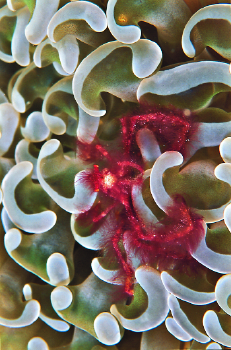 It lives in association with several different anemones and has to be one of the oddest-looking crabs with its body and legs covered with long flowing red hairs and having two large red eyes. Something like this would make a good candidate for Hollywood monster movie!
It lives in association with several different anemones and has to be one of the oddest-looking crabs with its body and legs covered with long flowing red hairs and having two large red eyes. Something like this would make a good candidate for Hollywood monster movie!
As for some odd looking shrimp, probably the weirdest looking shrimp I’ve even seen, which looks more like some prehistoric lizard monster, is the Gorgonian Horned Shrimp Miropandalus hardingi. 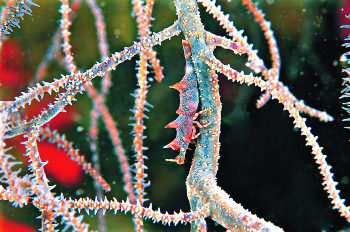 And no, I’m not joking here, as this is really a shrimp, even though it does not fit what we aquarists usually expect shrimp to look like! This is another very small creature, slightly less than 1 inch (2.0 cm). It’s found in the Tropical Central Indo-Pacific from Malaysia to southern Japan, and lives exclusively on wire or black corals in outer and coastal reef areas. This creature, which also mimics the color of the surface its upon, is slow moving and very uncommon as its ‘rarely’ observed in the wild.
And no, I’m not joking here, as this is really a shrimp, even though it does not fit what we aquarists usually expect shrimp to look like! This is another very small creature, slightly less than 1 inch (2.0 cm). It’s found in the Tropical Central Indo-Pacific from Malaysia to southern Japan, and lives exclusively on wire or black corals in outer and coastal reef areas. This creature, which also mimics the color of the surface its upon, is slow moving and very uncommon as its ‘rarely’ observed in the wild.
Okay, there’s no doubt the above species was an extraordinary looking ‘shrimp,’ but so is the Saw-Blade Shrimp, Tozeuma armatum! 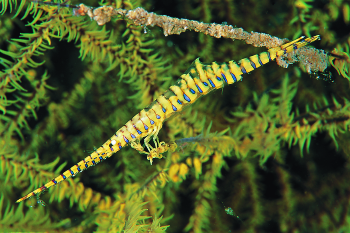 Yes, it looks more like a pipefish, but honestly, it’s a shrimp! It is found in the Tropical Indo-Pacific: from the Red Sea and East Africa to southern Japan and New Caledonia. It’s another crustacean that lives solely on black coral colonies in coastal and outer reef areas. It reaches about 2 inches (5 cm) in length with its body colors closely matching the coloration of the coral it lives upon. In fact, from what I understand from divers being able to see one, unless they pause in their dive area and await some movement of this creature, it’s almost impossible to tell it from the coral in the area.
Yes, it looks more like a pipefish, but honestly, it’s a shrimp! It is found in the Tropical Indo-Pacific: from the Red Sea and East Africa to southern Japan and New Caledonia. It’s another crustacean that lives solely on black coral colonies in coastal and outer reef areas. It reaches about 2 inches (5 cm) in length with its body colors closely matching the coloration of the coral it lives upon. In fact, from what I understand from divers being able to see one, unless they pause in their dive area and await some movement of this creature, it’s almost impossible to tell it from the coral in the area.
As for something we would expect a ‘shrimp’ to look like, it’s the exceptionally beautiful Coleman’s Shrimp, Periciemens colemani. This very uncommon shrimp, which attains a length slightly less than 1 inch (2 cm), is found in the Tropical Central Indo-Pacific from Malaysia to Australia. 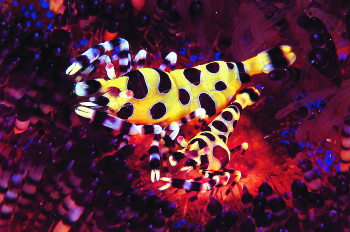 It is exclusively found among the spines of the fire urchin Asthenosoma avrium, where it is usually seen in pairs, with the female being slightly larger than the male. Its pale yellow body has large purple spots edged with white, and purple-banded legs and chelipeds. I only know of one making it into the trade, as it arrived in a shipment of various invertebrate at a west coast distributor and just happen to be in a tank when I was walking through their establishment. Unfortunately, it was a lot less colorful than the one in the photograph, but was probably stressed out, as only one very small urchin was in the same tank.
It is exclusively found among the spines of the fire urchin Asthenosoma avrium, where it is usually seen in pairs, with the female being slightly larger than the male. Its pale yellow body has large purple spots edged with white, and purple-banded legs and chelipeds. I only know of one making it into the trade, as it arrived in a shipment of various invertebrate at a west coast distributor and just happen to be in a tank when I was walking through their establishment. Unfortunately, it was a lot less colorful than the one in the photograph, but was probably stressed out, as only one very small urchin was in the same tank.
After seeing some of these extraordinary looking animals I wonder if some of them will purposely make it into the trade some day soon. I would assume so, as there is always a demand for small colorful creatures in our hobby. Unfortunately, the husbandry skills for maintaining such odd species, especially those tied to specific hosts, is certainly not yet capable of doing so. Yet, as the hobby progresses in its ability to maintain creatures needing very special care, especially where nano aquariums are concerned as there is great focus on these small systems and their associated equipment, the day where ‘some’ of these odd looking creatures may soon become doable. But meanwhile, as more and more of these bizarre-looking creatures show up in the media, lets divert some of our attention to learning far more about them and their surroundings before giving any thought to having one in our aquaria.
Photos by Andrea & Antonella Ferrari